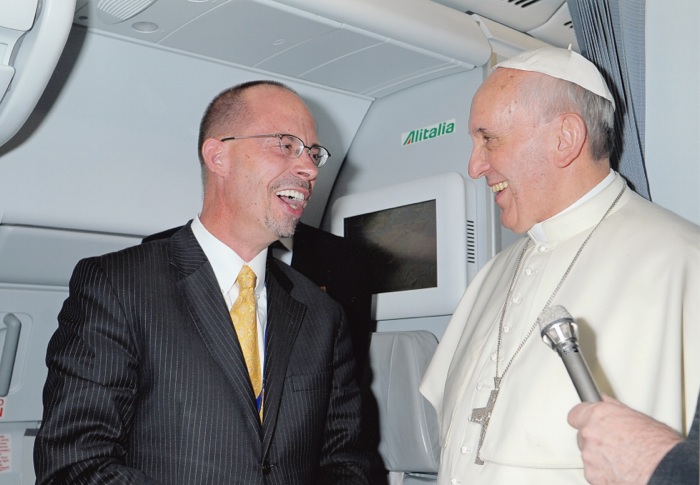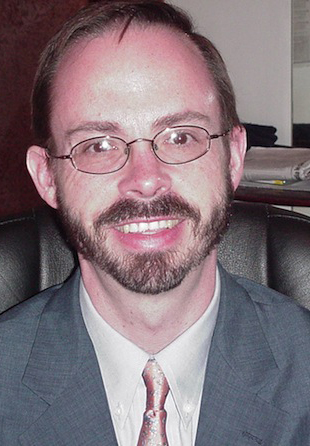Until recently, John L. Allen, Jr. was a senior correspondent for the National Catholic Reporter, one of the largest independent Catholic news publications. He’s the author of the “All Things Catholic” column, senior Vatican analyst for CNN, and the author of nine books on Vatican and Catholic affairs. He’s widely-held as one of the most knowledgeable and respected reporters on the Vatican.

Photo credit: L’Osservatore Romano via John Allen, Jr.
This January, Allen got recruited for a new job: associate editor leading a new Catholicism coverage project at the Boston Globe. The idea: Boston’s regional paper will build out a new Globe website dedicated to the coverage of one world religion, Catholicism.
A site about one religion operated under the auspices of a secular news organization is fairly unprecedented, at least in the States. (In Europe, the large Italian publisher Mondadori is launching a magazine dedicated to coverage of Pope Francis.)
Notably, this is not the Globe’s only new project. The Boston Globe has been unbundling. The Globe’s site has moved to a metered paywall, there are new plans for Boston.com, and they recently launched two niche sites: BDCwire and BetaBoston. Allen is part of a this unbundling mix.
I chatted with Allen about how he got recruited for the Globe from a Catholic news source, what most secular coverage on religion usually lacks, and why Boston’s regional paper might want to embark on a website that isn’t just about Boston.
John, what’s the vision with your joining the Boston Globe? How did it come to be?
J OHN L. ALLEN JR.: I was approached by John Henry, the new owner, to gauge my interest level, who then turned the conversation over to Brian McGrory, the Globe’s editor. In the course of our talks, it became clear that the Globe is serious about trying to position itself as a premier resource for reporting and analysis on the Catholic Church.
OHN L. ALLEN JR.: I was approached by John Henry, the new owner, to gauge my interest level, who then turned the conversation over to Brian McGrory, the Globe’s editor. In the course of our talks, it became clear that the Globe is serious about trying to position itself as a premier resource for reporting and analysis on the Catholic Church.
Since that’s what I’ve done for a living for almost two decades, it seemed a good fit.
How do the Globe’s new ideas about covering Catholicism differ from how other media outlets already cover the Pope and the Vatican?
ALLEN: Generally speaking, what you’ve got are a variety of specialized Catholic news agencies that provide regular Church coverage, with the “mainstream” media usually dipping in and out of the story as events seem to warrant. The result is that coverage outside the specialized Catholic sphere tends to be sporadic and, sometimes, devoid of context.
The difference here [with the project at the Globe] is that a major daily wants to cover the Catholic Church the way newspapers cover City Hall or the White House, meaning as a priority. The hope is to blend the advantages of a secular platform, such as the Globe’s network of reporters and contributors, with the expertise that only comes from paying careful attention to a story over a long time.
What are the advantages that a secular publication has in covering a religion, versus something like a Catholic publication, or say, a Jewish publication? Is it all about reach?
ALLEN: Obviously the reach and resources the Globe can bring are important, but I also think a secular publication has a big advantage in not being identified with one side or another in a religious group’s internal tensions.
Religion stirs deep passions, which is a primary reason it’s long been considered a bad subject for dinner conversation. Given how heavily invested folks tend to be in Church politics – whether Catholicism ought to rethink its teachings on homosexuality, for instance, or whether it’s really learned the lessons of its child sexual abuse scandals – it can be tough to find venues that genuinely play fair with all sides.
I’ve long said that the trick to covering religion is to be close enough to the story to get it right, but far enough away to remain objective … or, at least, as close to objectivity as humanly possible. If we pull it off, this new endeavor at the Globe gives us a decent shot at striking that balance.
Who is the audience for your planned coverage at the Globe? Is this a publication for Catholics or one about Catholicism, for others?
ALLEN: The audience is anybody who’s interested in the Pope (a fairly big demographic these days, in light of the fascination with Francis), the Vatican, and the Catholic Church, both here in the States and around the world.
Defined that way, the audience is obviously national and international. There are 1.2 billion Catholics in the world, so that’s a fairly sizeable potential market, to say nothing of the fact that you don’t have to be Catholic to recognize the important role the Church plays in social, cultural and even political life. The hope is to position the Globe as a go-to destination for anyone seeking an informed, objective take on what’s happening in the Catholic Church, no matter where they live and no matter what religion, if any, they follow.
What’s the plan for growth? How will you bring to the site the audience you’ve described?
ALLEN: Content is king, before any design or marketing strategy. Here’s an example. In late February, Pope Francis unveiled a sweeping reform of the Vatican’s financial operations designed to foster greater transparency and accountability. He named an Australian cardinal to head a new finance ministry and a Maltese layman to help run a new supervisory council, and both did their only interviews for an American news outlet with the Globe. People who wanted to know how these key officials understand their new roles came to the Globe to get the story. If we do that sort of thing often enough, we’ll train anyone interested in Catholic affairs to look to the Globe.
The Globe appears to be launching many new verticals, all aimed at particular niche audiences or types of news readers. The Globe is for the heavier news reader, Boston.com is being positioned for information-grazers. Then BetaBoston.com has the local startup and tech industries. And BDCwire has the arts and entertainment for the area’s younger crowd. This new Catholicism project seems different — it’s not just about a local vested interest. It’s not even, really, about Boston. How do you see this project as fitting at the Globe?
ALLEN: You’re right, it not’s fundamentally about Boston, but in a sense that’s the whole idea. The Globe aspires to being nationally and internationally relevant, and to do that it’s got to have a few areas where it leads the pack on news that transcends local interests.
You might also be interested in:
By sending data from their targeted audiences in Adobe Analytics into MFN, Crain was able to more clearly understand what topics, categories, and even story types were engaging readers in key parts of their coverage area.
Ways to support conversations for balancing innovation and stability in your news organization, essential considerations about this often overlooked topic, and guidance to include them in your technology decisions.
Successfully and efficiently marketing your work can be hard, especially for local news teams with limited resources, but marketing yourself to your audience is an essential skill for news organizations to drive revenue and promote sustainability.


